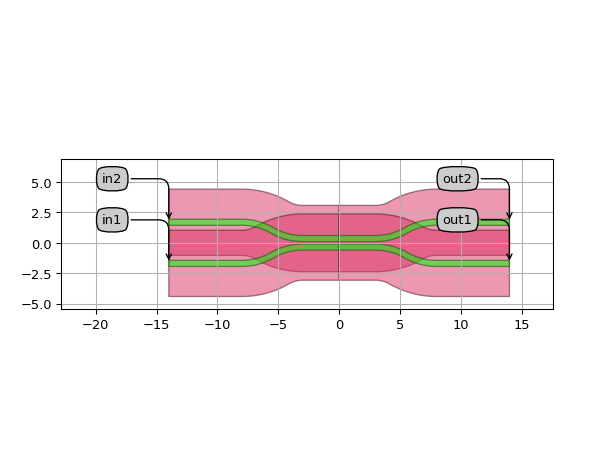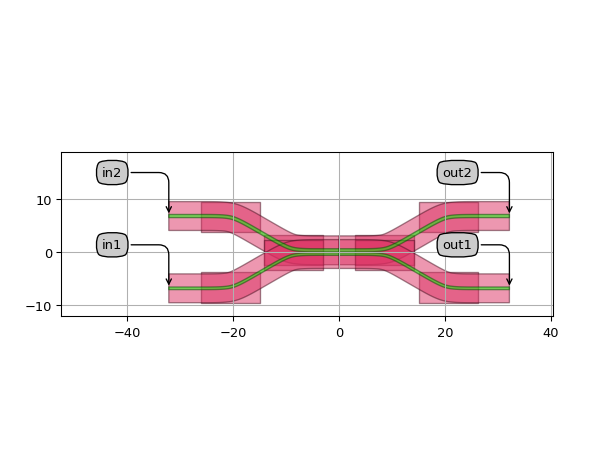SBendDirectionalCoupler
- class picazzo3.wg.dircoup.cell.SBendDirectionalCoupler
A directional coupler consisting of 2 parallel (horizontal) waveguides with S-shaped bends at the start and end.
- Parameters:
- wg2b: PCell
North-east waveguide
- wg2a: PCell
North-west waveguide
- wg1b: PCell
South-east waveguide
- wg1a: PCell
South-west waveguide
- trace_template2: PCell and _WaveguideTemplate
waveguide template used by the north arm of the directional coupler. If not set, it defaults to the template of the south arm
- trace_template1: PCell and _WaveguideTemplate
waveguide template used by the south arm of the directional coupler
- coupler_length: float and Real, number and number >= 0
length of the directional coupler
- name: String that contains only ISO/IEC 8859-1 (extended ASCII py3) or pure ASCII (py2) characters
The unique name of the pcell
- Other Parameters:
- n_inputs: int and number > 0, locked
Number of input channels.
- n_outputs: int and number > 0, locked
Number of output channels.
Views
- class Layout
- Parameters:
- sbend_straight: float and Real, number and number >= 0
length of the straight section in the S-bend
- bend_angles2: tuple2
Input and output angle of the bends of arm 2. Defaults to bend_angle. If set, bend_angle will be ignored.
- bend_angles1: tuple2
Input and output angle of the bends of arm 1. Defaults to bend_angle. If set, bend_angle will be ignored.
- straight_after_bend: float and Real, number and number >= 0
length of the straight waveguide after the bend
- bend_angle: float
angle at which the directional coupler is bent
- reverse_individual_bends2b: List with type restriction, allowed types: <class ‘bool’>
List of booleans to indicate whether the individual bends in arm2 should be reversed
- reverse_individual_bends1b: List with type restriction, allowed types: <class ‘bool’>
List of booleans to indicate whether the individual bends in arm1 should be reversed
- reverse_individual_bends2a: List with type restriction, allowed types: <class ‘bool’>
List of booleans to indicate whether the individual bends in arm2 should be reversed
- reverse_individual_bends1a: List with type restriction, allowed types: <class ‘bool’>
List of booleans to indicate whether the individual bends in arm1 should be reversed
- reverse_bends: ( bool, bool_ or int )
If True, all bends will be reversed. This has only an effect on asymmetric bends, such as splines
- wg2b_shape: Shape
Shape for the north-east part of the waveguide
- wg2a_shape: Shape
Shape for the north-west part of the waveguide
- wg1b_shape: Shape
Shape for the south-east part of the waveguide
- wg1a_shape: Shape
Shape for the south-west part of the waveguide
- coupler_spacing: float
Spacing between the two waveguide centerlines.
- view_name: String that contains only alphanumeric characters from the ASCII set or contains _$. ASCII set is extended on PY3.
The name of the view
- manhattan: ( bool, bool_ or int )
Adds rectangular blocks in the bends to avoid as much as possible non-manhattan angles.
- angle_step: float and number > 0
Angle step for rounding.
- rounding_algorithm:
Rounding algorithm used to generate the bends. Can be circular, spline, ….
- bend_radius: float and number > 0
Bend radius for the auto-generated bends.
Examples
import si_fab.all as pdk # noqa: F401 from picazzo3.wg.dircoup import SBendDirectionalCoupler from picazzo3.traces.wire_wg.trace import WireWaveguideTemplate import ipkiss3.all as i3 wg_t = WireWaveguideTemplate() wg_t.Layout(core_width=0.500, cladding_width=i3.TECH.WG.CLADDING_WIDTH, core_process=i3.TECH.PROCESS.WG) C = SBendDirectionalCoupler(name="my_sbenddircoup3", trace_template1=wg_t, coupler_length=6.0) layout = C.Layout(coupler_spacing=0.7, straight_after_bend=6.0, bend_angle=30.0) layout.visualize(annotate=True)

"""A more complicated example using asymmetric spline bends and different waveguide definition in the two arms. """ import si_fab.all as pdk # noqa: F401 from picazzo3.wg.dircoup import SBendDirectionalCoupler from picazzo3.traces.wire_wg.trace import WireWaveguideTemplate from ipkiss3.all import SplineRoundingAlgorithm import ipkiss3.all as i3 wg_t = WireWaveguideTemplate(name="my_wg_template4") wg_t.Layout(core_width=0.500, cladding_width=i3.TECH.WG.CLADDING_WIDTH, core_process=i3.TECH.PROCESS.WG) wg_t2 = WireWaveguideTemplate(name="my_wg_template5") wg_t2.Layout( core_width=0.600, cladding_width=i3.TECH.WG.CLADDING_WIDTH, core_process=i3.TECH.PROCESS.WG ) ra = SplineRoundingAlgorithm(adiabatic_angles=(30.0, 0)) # asymmetric C = SBendDirectionalCoupler( name="my_sbenddircoup_4", trace_template1=wg_t, trace_template2=wg_t2, coupler_length=6.0 ) layout = C.Layout( coupler_spacing=0.7, bend_radius=5.0, manhattan=True, straight_after_bend=6.0, sbend_straight=1.0, bend_angle=30.0, rounding_algorithm=ra, ) layout.visualize(annotate=True)
